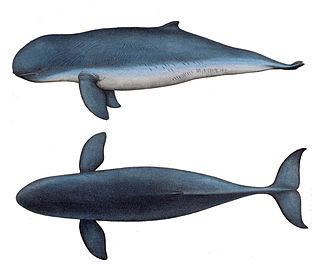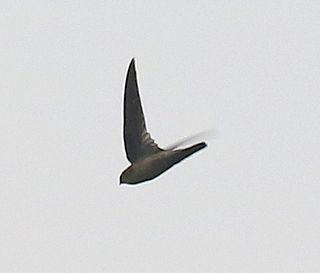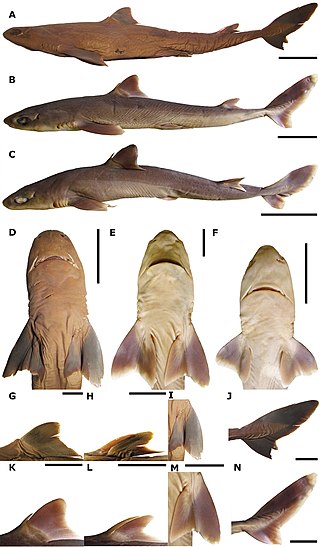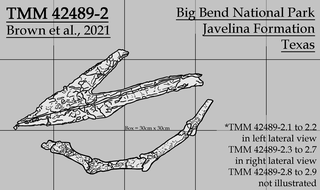
The snubfin dolphins (Orcaella) are a genus of cetaceans containing two members: the Irrawaddy dolphin and the Australian snubfin dolphin. The genus was long believed to be monotypic with the only species being the Irrawaddy dolphin; however, in 2005, supposed Irrawaddy dolphin populations inhabiting the Australian/New Guinean regions were found to be significantly different and were declared a separate new species named the Australian snubfin dolphin.

The red-legged kittiwake is a seabird species in the gull family Laridae. It breeds in the Pribilof Islands, Bogoslof Island, and Buldir Island in the Bering Sea off the coast of Alaska, and the Commander Islands, Russia, and spends the winter at sea.

The lemon shark is a species of shark from the family Carcharhinidae and is classified as a Vulnerable species by the International Union for the Conservation of Nature. Lemon sharks can grow to 3.4 metres (11 ft) in length. They are often found in shallow subtropical waters and are known to inhabit and return to specific nursery sites for breeding. Often feeding at night, these sharks use electroreceptors to find their main source of prey, fish. Lemon sharks enjoy the many benefits of group living such as enhanced communication, courtship, predatory behavior, and protection. This species of shark gives birth to live young, and the females are polyandrous and have a biennial reproductive cycle. Lemon sharks are not thought to be a large threat to humans; there have been 10 recorded bites, none of which were life-threatening. The lemon shark's life span is unknown, but the average shark is 25 to 30 years old.

Kittlitz's murrelet is a small alcid found in the waters off Alaska and Eastern Siberia. This near threatened species is, like the closely related marbled murrelet, unusual for seabirds in not being colonial, nesting instead in isolated locations on mountain tops, where the nests were known to Native Americans for many years before skeptical ornithologists described and photographed them. It is a poorly known and little studied species, although concern over its status and that of the closely related marbled murrelet has led to a recent increase in research.

Pachycrocuta is an extinct genus of prehistoric hyenas. The largest and most well-researched species is Pachycrocuta brevirostris, colloquially known as the giant short-faced hyena as it stood about 90–100 cm (35–39 in) at the shoulder and it is estimated to have averaged 110 kg (240 lb) in weight, approaching the size of a lioness, making it the largest known hyena. Pachycrocuta first appeared during the late Miocene. By 800,000 years ago, it became locally extinct in Europe, with it surviving in East Asia until at least 500,000 years ago, and possibly later elsewhere in Asia.

The weebill is a species of bird in the family Acanthizidae. It is an insectivorous passerine that is found throughout mainland Australia. At 8 to 9 cm long, it is Australia's smallest bird. It was originally described by John Gould in 1838, and four subspecies are recognised. The weebill's plumage is nondescript, with olive-grey upperparts and paler, more yellowish underparts. It grades from more brownish plumage in the southern regions of Australia to more yellow in tropical areas.

The Kerguelen petrel is a small slate-grey seabird in the family Procellariidae. It is the only species placed in the genus Aphrodroma. It is a pelagic, circumpolar seabird of the Southern Ocean. It breeds on islands in the southern Atlantic and Indian Oceans.

The Himalayan swiftlet is a small swift. It is a common colonial breeder in the Himalayas and Southeast Asia. Some populations are migratory.
The short-nosed harvest mouse is a species of rodent in the family Cricetidae found in Costa Rica and Nicaragua. It is currently of Least Concern in endangerment status.

The chestnut sac-winged bat, or Wagner's sac-winged bat is a species of sac-winged bat native to South and Central America. It is the only species within its genus.
Duttaphrynus brevirostris is a species of toad in the family Bufonidae. It is endemic to the Western Ghats in India, where it is only known from the state of Karnataka.

The Cameroon forest tree frog is a species of frog in the family Arthroleptidae. It is found in southern Nigeria, Cameroon, Equatorial Guinea, and Gabon. It is expected to occur in southwestern Central African Republic and in the Republic of the Congo, but no records have been confirmed from those countries.

The short-billed minivet is a species of bird in the family Campephagidae. It is found in Bangladesh, Bhutan, Cambodia, China, India, Laos, Myanmar, Nepal, Thailand, and Vietnam. Its natural habitats are subtropical or tropical moist lowland forest and subtropical or tropical moist montane forest.

The eye-ringed flatbill is a species of bird in the family Tyrannidae. It is found in Belize, Colombia, Costa Rica, El Salvador, Guatemala, Honduras, Mexico, Nicaragua, and Panama, with a slight incursion into Colombia at the south end of its range. Its natural habitats are subtropical or tropical moist lowland forests and subtropical or tropical moist montane forests.

The Japanese shortnose spurdog is a dogfish shark in the genus Squalus. It is found from southern Japan to the South China Sea. The length of the longest specimen measured is 60 cm (24 in).

Malacanthus brevirostris, the quakerfish, flagtail blanquillo, false whiting or stripetail tilefish, is a species of marine ray-finned fish, a tilefish belonging to the family Malacanthidae. It has a wide Indo-Pacific distribution.
Caiman brevirostris is an extinct species of caiman that lived during the Late Miocene, around 11.6 million years ago, to the end of the Miocene 5.3 million years ago in Acre and Amazonas, Brazil as well as Urumaco, Venezuela. Several specimens have been referred to the species, but only 3 of them are confidently placed in the species. C. brevirostris was originally named in 1987 on the basis of a single, incomplete rostrum with an associated mandibular ramus that had been found in Acre, Brazil. C. brevirostris is very distinct among Caiman species and caimaninae overall in that it preserves a characteristically short and robust skull that bears blunt posterior teeth that were built to break down harder foods. This was an adaption for durophagy, likely to crush shells of mollusks and clams which were common in the wetlands that C. brevirostris resided in.

Anolis brevirostris, the desert gracile anole or shortnose anole, is a species of lizard in the family Dactyloidae. The species is found in Hispaniola.

Wellnhopterus is an azhdarchid pterosaur recovered from the Late Cretaceous Javelina Formation in Texas that was previously identified as a thalassodromine. It consists of a set of upper and lower jaws, as well as some cervical vertebrae and a fragmentary long bone. In July 2021, the jaws were given the genus name "Javelinadactylus", with the type and only species as "J. sagebieli"; however, this article has now been retracted. In a paper published in December 2021, the complete holotype was independently named Wellnhopterus, with the only species being W. brevirostris. As of 2022, this is the formal name of this pterosaur.

Stizocephalus is a genus of dirt-colored seed bugs in the family Rhyparochromidae. There are about seven described species in Stizocephalus.

















